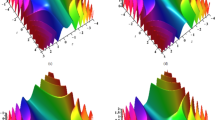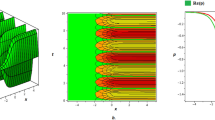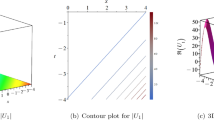Abstract
The Peregrine soliton is a localized nonlinear structure predicted to exist over 25 years ago, but not so far experimentally observed in any physical system1. It is of fundamental significance because it is localized in both time and space, and because it defines the limit of a wide class of solutions to the nonlinear Schrödinger equation (NLSE). Here, we use an analytic description of NLSE breather propagation2 to implement experiments in optical fibre generating femtosecond pulses with strong temporal and spatial localization, and near-ideal temporal Peregrine soliton characteristics. In showing that Peregrine soliton characteristics appear with initial conditions that do not correspond to the mathematical ideal, our results may impact widely on studies of hydrodynamic wave instabilities where the Peregrine soliton is considered a freak-wave prototype3,4,5,6,7.
This is a preview of subscription content, access via your institution
Access options
Subscribe to this journal
Receive 12 print issues and online access
$259.00 per year
only $21.58 per issue
Buy this article
- Purchase on SpringerLink
- Instant access to full article PDF
Prices may be subject to local taxes which are calculated during checkout





Similar content being viewed by others
References
Peregrine, D. H. Water waves, nonlinear Schrödinger equations and their solutions. J. Aust. Math. Soc. Ser. B 25, 16–43 (1983).
Akhmediev, N. & Korneev, V. I. Modulation instability and periodic solutions of the nonlinear Schrödinger equation. Theor. Math. Phys. 69, 1089–1093 (1986).
Henderson, K. L, Peregrine, D. H. & Dold, J. W. Unsteady water wave modulations: Fully nonlinear solutions and comparison with the nonlinear Schrödinger equation. Wave Motion 29, 341–361 (1999).
Dysthe, K. B. & Trulsen, K. Note on breather type solutions of the NLS as models for freak-waves. Phys. Scripta 82, 48–52 (1999).
Kharif, C., Pelinovsky, E. & Slunyaev, A. Rogue Waves in the Ocean (Springer-Verlag, 2009).
Akhmediev, N., Soto-Crespo, J. M. & Ankiewicz, A. Extreme waves that appear from nowhere: On the nature of rogue waves. Phys. Lett. A 373, 2137–2145 (2009).
Shrira, V. I. & Geoigjaev, V. V. What makes the Peregrine soliton so special as a prototype of freak waves? J. Eng. Math. 67, 11–22 (2010).
Taylor, J. R. (ed.) Optical Solitons Theory & Experiment (Cambridge Univ. Press, 1992).
Dauxois, Th. & Peyrard, M. Physics of Solitons (Cambridge Univ. Press, 2006).
Denschlag, J. et al. Generating solitons by phase engineering of a Bose–Einstein condensate. Science 287, 97–101 (2000).
Fermi, E., Pasta, J. & Ulam, S. in Collected Papers of Enrico Fermi (ed. Segre, E.) 978–988 (Univ. Chicago Press, 1965).
Akhmediev, N. & Ankiewicz, A. Solitons, Nonlinear Pulses and Beams (Chapman and Hall, 1997).
Sato, M. & Sievers, A. J. Direct observation of the discrete character of intrinsic localized modes in an antiferromagnet. Nature 432, 486–488 (2004).
Bespalov, V. I. & Talanov, V. J. Filamentary structure of light beams in nonlinear liquids. JETP Lett. 3, 307–310 (1966).
Benjamin, T. B. & Feir, J. E. The disintegration of wavetrains on deep water. Part 1: Theory. J. Fluid Mech. 27, 417–430 (1967).
Hasegawa, A. Generation of a train of soliton pulses by induced modulational instability in optical fibres. Opt. Lett. 9, 288–290 (1984).
Tai, K., Tomita, A., Jewell, J. L. & Hasegawa, A. Generation of subpicosecond solitonlike optical pulses at 0.3 THz repetition rate by induced modulational instability. Appl. Phys. Lett. 49, 236–238 (1986).
Hart, D. L., Judy, A. F., Roy, R. & Beletic, J. W. Dynamical evolution of multiple four-wave-mixing processes in an optical fiber. Phys. Rev. E 57, 4757–4774 (1998).
Greer, E. J., Patrick, D. M., Wigley, P. G. J. & Taylor, J. R. Generation of 2 THz repetition rate pulse trains through induced modulational instability. Electron. Lett. 25, 1246–1248 (1989).
Mamyshev, P. V., Chernikov, S. V., Dianov, E. M. & Prokhorov, A. M. Generation of a high-repetition-rate train of practically noninteracting solitons by using the induced modulational instability and Raman self-scattering effects. Opt. Lett. 15, 1365–1367 (1990).
Trillo, S. & Wabnitz, S. Dynamics of the nonlinear modulational instability in optical fibres. Opt. Lett. 16, 986–988 (1991).
Fatome, J., Pitois, S. & Millot, G. 20-GHz-to-1-THz repetition rate pulse sources based on multiple four-wave mixing in optical fibers. IEEE J. Quantum Electron. 42, 1038–1046 (2006).
Van Simaeys, G., Emplit, Ph. & Haelterman, M. Experimental demonstration of the Fermi–Pasta–Ulam recurrence in a modulationally unstable optical wave. Phys. Rev. Lett. 87, 033902 (2001).
Dudley, J. M., Genty, G., Dias, F., Kibler, B. & Akhmediev, N. Modulation instability, Akhmediev Breathers and continuous wave supercontinuum generation. Opt. Exp. 17, 21497–21508 (2009).
Dudley, J. M., Finot, C., Richardson, D. J. & Millot, G. Self similarity in ultrafast nonlinear optics. Nature Phys. 3, 597–603 (2007).
Solli, D. R., Ropers, C., Koonath, P. & Jalali, B. Optical rogue waves. Nature 450, 1054–1057 (2007).
Doktorov, E. V., Rothos, V. M. & Kivshar, Y. S. Full-time dynamics of modulational instability in spinor Bose–Einstein condensates. Phys. Rev. A 76, 013626 (2007).
Agrawal, G. P. Nonlinear Fibre Optics 4th edn (Academic, 2007).
Dudley, J. M. et al. Complete intensity and phase characterisation of optical pulse trains at THz repetition rates. Electron. Lett. 35, 2042–2044 (1999).
Dudley, J. M., Genty, G. & Coen, S. Supercontinuum generation in photonic crystal fibre. Rev. Mod. Phys. 78, 1135–1184 (2006).
Acknowledgements
We acknowledge support from the French Agence Nationale de la Recherche projects MANUREVA ANR-08-SYSC-019 and IMFINI ANR-09-BLAN-0065, the Academy of Finland Research grants 132279 and 130099, the 2008 Framework Program for Research, Technological development and Innovation of the Cyprus Research Promotion Foundation under the Project ASTI/0308(BE)/05 and the Australian Research Council Discovery Project scheme DP0985394.
Author information
Authors and Affiliations
Contributions
B.K., J.F., C.F. and J.M.D. carried out experiments. The development of analytical tools and simulations was carried out by B.K., G.M., G.G., F.D., N.A. and J.M.D. All authors participated in the analysis and interpretation of the results and the writing of the paper.
Corresponding author
Ethics declarations
Competing interests
The authors declare no competing financial interests.
Rights and permissions
About this article
Cite this article
Kibler, B., Fatome, J., Finot, C. et al. The Peregrine soliton in nonlinear fibre optics. Nature Phys 6, 790–795 (2010). https://doi.org/10.1038/nphys1740
Received:
Accepted:
Published:
Issue date:
DOI: https://doi.org/10.1038/nphys1740
This article is cited by
-
Dynamics of transformed nonlinear waves in an extended (3+1)-dimensional Ito equation: state transitions and interactions
Nonlinear Dynamics (2024)
-
Optical soliton resonances, soliton molecules to breathers for a defocusing Lakshmanan–Porsezian–Daniel system
Optical and Quantum Electronics (2024)
-
Switching, explosion, and chaos of multi-wavelength soliton states in ultrafast fiber lasers
Science China Physics, Mechanics & Astronomy (2024)
-
Characteristics of localized waves of multi-coupled nonlinear Schrödinger equation
Optical and Quantum Electronics (2024)
-
Periodic, n-soliton and variable separation solutions for an extended (3+1)-dimensional KP-Boussinesq equation
Scientific Reports (2023)



